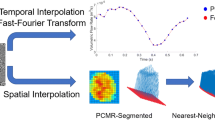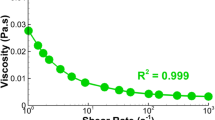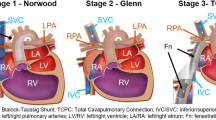Abstract
Flow efficiency through the Fontan connection is an important factor related to patient outcomes. It can be quantified using either a simplified power loss or a viscous dissipation rate metric. Though practically equivalent in simplified Fontan circulation models, these metrics are not identical. Investigation is needed to evaluate the advantages and disadvantages of these metrics for their use in in vivo or more physiologically-accurate Fontan modeling. Thus, simplified power loss and viscous dissipation rate are compared theoretically, computationally, and statistically in this study. Theoretical analysis was employed to assess the assumptions made for each metric and its clinical calculability. Computational simulations were then performed to obtain these two metrics. The results showed that apparent simplified power loss was always greater than the viscous dissipation rate for each patient. This discrepancy can be attributed to the assumptions derived in theoretical analysis. Their effects were also deliberately quantified in this study. Furthermore, statistical analysis was conducted to assess the correlation between the two metrics. Viscous dissipation rate and its indexed quantity show significant, strong, linear correlation to simplified power loss and its indexed quantity (p < 0.001, r > 0.99) under certain assumptions. In conclusion, viscous dissipation rate was found to be more advantageous than simplified power loss as a hemodynamic metric because of its lack of limiting assumptions and calculability in the clinic. Moreover, in addition to providing a time-averaged bulk measurement like simplified power loss, viscous dissipation rate has spatial distribution contours and time-resolved values that may provide additional clinical insight. Finally, viscous dissipation rate could maintain the relationship between Fontan connection flow efficiency and patient outcomes found in previous studies. Consequently, future Fontan hemodynamic studies should calculate both simplified power loss and viscous dissipation rate to maintain ties to previous studies, but also provide the most accurate measure of flow efficiency. Additional attention should be paid to the assumptions required for each metric.






Similar content being viewed by others
References
Bakhshinejad, A., A. Baghaie, A. Vali, D. Saloner, V. L. Rayz, and R. M. D’Souza. Merging computational fluid dynamics and 4D flow MRI using proper orthogonal decomposition and ridge regression. J. Biomech 2017. https://doi.org/10.1016/j.jbiomech.2017.05.004.
Bland, J. M., and D. G. Altman. Measuring agreement in method comparison studies. Stat. Methods Med. Res 8:135–160, 1999.
Chandran, K. B., S. E. Rittgers, and A. P. Yoganathan. Biofluid Mechanics: The Human Circulation. CRC Press, Taylor & Francis Group, 2012, p. 431. https://www.crcpress.com/Biofluid-Mechanics-The-Human-Circulation-Second-Edition/Chandran-Rittgers-Yoganathan/p/book/9781439845165.
Cheng, A. L., C. M. Takao, R. B. Wenby, H. J. Meiselman, J. C. Wood, and J. A. Detterich. Elevated low-shear blood viscosity is associated with decreased pulmonary blood flow in children with univentricular heart defects. Pediatr. Cardiol. 37:789–801, 2016.
Chopski, S. G., O. M. Rangus, W. B. Moskowitz, and A. L. Throckmorton. Experimental measurements of energy augmentation for mechanical circulatory assistance in a patient-specific fontan model. Artif. Organs 38:791–799, 2014.
Cibis, M., K. Jarvis, M. Markl, M. Rose, C. Rigsby, A. J. Barker, and J. J. Wentzel. The effect of resolution on viscous dissipation measured with 4D flow MRI in patients with Fontan circulation: Evaluation using computational fluid dynamics. J. Biomech. 48:2984–2989, 2015.
Dasi, L. P., K. Pekkan, H. D. Katajima, and A. P. Yoganathan. Functional analysis of Fontan energy dissipation. J. Biomech. 41:2246–2252, 2008.
Dubini, G., M. R. de Leval, R. Pietrabissa, F. M. Montevecchi, and R. Fumero. A numerical fluid mechanical study of repaired congenital heart defects. Application to the total cavopulmonary connection. J. Biomech. 29:111–121, 1996.
Ensley, A. E., P. Lynch, G. P. Chatzimavroudis, C. Lucas, S. Sharma, and A. P. Yoganathan. Toward designing the optimal total cavopulmonary connection: An in vitro study. Ann. Thorac. Surg. 68:1384–1390, 1999.
Fung, Y. C. Biomechanics: Circulation. New York: Springer, 1997.
Grigioni, M., G. D. Avenio, C. Del Gaudio, and U. Morbiducci. Critical issues in studies of flow through the Fontan circuit after 10 years of investigation. Cardiol. Young 15:68–73, 2005.
Ha, H., G. B. Kim, J. Kweon, S. J. Lee, Y.-H. Kim, D. H. Lee, D. H. Yang, and N. Kim. Hemodynamic measurement using four-dimensional phase-contrast MRI: Quantification of hemodynamic parameters and clinical applications. Korean J. Radiol. 17:445, 2016.
Haggerty, C. M., M. Restrepo, E. Tang, D. A. de Zélicourt, K. S. Sundareswaran, L. Mirabella, J. Bethel, K. K. Whitehead, M. A. Fogel, and A. P. Yoganathan. Fontan hemodynamics from 100 patient-specific cardiac magnetic resonance studies: A computational fluid dynamics analysis. J. Thorac. Cardiovasc. Surg. 148:1481–1489, 2014.
Haggerty, C. M., K. K. Whitehead, J. Bethel, M. A. Fogel, and A. P. Yoganathan. Relationship of single ventricle filling and preload to total cavopulmonary connection hemodynamics. Ann. Thorac. Surg. 99:911–917, 2015.
Healy, T. M., C. Lucas, and A. P. Yoganathan. Noninvasive fluid dynamic power loss assessments for total cavopulmonary connections using the viscous dissipation function: A feasibility study. J. Biomech. Eng. 123:317, 2001.
Johnston, B. M., P. R. Johnston, S. Corney, and D. Kilpatrick. Non-Newtonian blood flow in human right coronary arteries: Steady state simulations. J. Biomech. 37:709–720, 2004.
Khiabani, R. H., K. K. Whitehead, D. Han, M. Restrepo, E. Tang, J. Bethel, S. M. Paridon, M. A. Fogel, and A. P. Yoganathan. Exercise capacity in single-ventricle patients after Fontan correlates with haemodynamic energy loss in TCPC. Heart 101:139–143, 2015.
Lardo, A. C., S. A. Webber, I. Friehs, P. J. Del Nido, and E. G. Cape. Fluid dynamic comparison of intra-atrial and extracardiac total cavopulmonary connections. J. Thorac. Cardiovasc. Surg. 117:697–704, 1999.
Long, C. C., M.-C. C. M. Hsu, Y. Bazilevs, J. A. Feinstein, and A. L. Marsden. Fluid—structure interaction simulations of the Fontan procedure using variable wall properties. Int. J. Numer. Method. Biomed. Eng. 28:513–527, 2012.
Low, H. T. T., Y. T. T. Chew, and C. N. N. Lee. Flow studies on atriopulmonary and cavopulmonary connections of the Fontan operations for congenital heart defects. J. Biomed. Eng. 15:303–307, 1993.
Moyle, K., G. Mallinson, and B. Cowan. Volumetric methods for evaluating irreversible energy losses and entropy production with application to bioengineering flows. Int. J. Numer. Methods Fluids 50:1357–1368, 2006.
Munson, B. R., D. F. Young, and T. H. Okiishi. Fundamentals of Fluid Mechanics. New York: Wiley, 2006.
Restrepo, M., M. Luffel, J. Sebring, K. R. Kanter, P. J. Del Nido, A. Veneziani, J. Rossignac, and A. P. Yoganathan. Surgical planning of the total cavopulmonary connection: robustness analysis. Ann. Biomed. Eng. 2014. https://doi.org/10.1007/s10439-014-1149-7.
Restrepo, M., E. Tang, C. M. Haggerty, R. H. Khiabani, L. Mirabella, J. Bethel, A. M. Valente, K. K. Whitehead, D. B. McElhinney, M. A. Fogel, and A. P. Yoganathan. Energetic implications of vessel growth and flow changes over time in fontan patients. Ann. Thorac. Surg. 99:163–170, 2015.
Santhanakrishnan, A., K. O. Maher, E. Tang, R. H. Khiabani, J. Johnson, and A. P. Yoganathan. Hemodynamic effects of implanting a unidirectional valve in the inferior vena cava of the Fontan circulation pathway: An in vitro investigation. Am. J. Physiol Heart. Circ. Physiol. 305:H1538–H1547, 2013.
Soerensen, D. D., K. Pekkan, K. S. Sundareswaran, and A. P. Yoganathan. New power loss optimized Fontan connection evaluated by calculation of power loss using high resolution PC-MRI and CFD. Conf. Proc. IEEE Eng. Med. Biol. Soc. 2:1144–1147, 2004.
Tang, E., M. Restrepo, C. M. Haggerty, L. Mirabella, J. Bethel, K. K. Whitehead, M. A. Fogel, and A. P. Yoganathan. Geometric characterization of patient-specific total cavopulmonary connections and its relationship to hemodynamics. JACC Cardiovasc. Imaging 7:215–224, 2014.
Tang, E., Z. Wei, K. K. Whitehead, R. H. Khiabani, M. Restrepo, L. Mirabella, J. Bethel, S. M. Paridon, B. S. Marino, M. A. Fogel, and A. P. Yoganathan. Effect of Fontan geometry on exercise haemodynamics and its potential implications. Heart 2017. https://doi.org/10.1136/heartjnl-2016-310855.
Volonghi, P., D. Tresoldi, M. Cadioli, A. M. Usuelli, R. Ponzini, U. Morbiducci, A. Esposito, and G. Rizzo. Automatic extraction of three-dimensional thoracic aorta geometric model from phase contrast MRI for morphometric and hemodynamic characterization. Magn. Reson. Med. 882:873–882, 2016.
Vukicevic, M., T. A. Conover, M. Jaeggli, J. Zhou, G. Pennati, T.-Y. T. Hsia, and R. S. Figliola. Control of respiration-driven retrograde flow in the subdiaphragmatic venous return of the Fontan circulation. ASAIO J. 60:21–23, 2014.
Wang, C., K. Pekkan, D. de Zélicourt, M. Horner, A. Parihar, A. Kulkarni, and A. P. Yoganathan. Progress in the CFD modeling of flow instabilities in anatomical total cavopulmonary connections. Ann. Biomed. Eng. 35:1840–1856, 2007.
Wei, Z. A., P. M. Trusty, M. Tree, C. M. Haggerty, E. Tang, M. Fogel, and A. P. Yoganathan. Can time-averaged flow boundary conditions be used to meet the clinical timeline for Fontan surgical planning? J. Biomech. 50:172–179, 2017.
Wei, Z., K. K. Whitehead, R. H. Khiabani, M. Tree, E. Tang, S. M. Paridon, M. A. Fogel, and A. P. Yoganathan. Respiratory effects on Fontan circulation during rest and exercise using real-time cardiac magnetic resonance imaging. Ann. Thorac. Surg. 101:1818–1825, 2016.
Whitehead, K. K., K. Pekkan, H. D. Kitajima, S. M. Paridon, A. P. Yoganathan, and M. A. Fogel. Nonlinear power loss during exercise in single-ventricle patients after the Fontan: Insights from computational fluid dynamics. Circulation 116:I-165–I-171, 2000.
Acknowledgments
This study was supported by the National Heart, Lung, and Blood Institute Grants HL67622 and HL098252. The authors acknowledge the use of ANSYS software which was provided through an Academic Partnership between ANSYS, Inc. and the Cardiovascular Fluid Mechanics Lab at the Georgia Institute of Technology. Additionally, the authors would like to acknowledge Luyu Zhang from Emory University for assistance in statistical analysis.
Conflict of interest
The authors report no conflicts of interest.
Author information
Authors and Affiliations
Corresponding author
Additional information
Associate Editor Peter E. McHugh oversaw the review of this article.
Rights and permissions
About this article
Cite this article
Wei, Z.A., Tree, M., Trusty, P.M. et al. The Advantages of Viscous Dissipation Rate over Simplified Power Loss as a Fontan Hemodynamic Metric. Ann Biomed Eng 46, 404–416 (2018). https://doi.org/10.1007/s10439-017-1950-1
Received:
Accepted:
Published:
Issue Date:
DOI: https://doi.org/10.1007/s10439-017-1950-1




